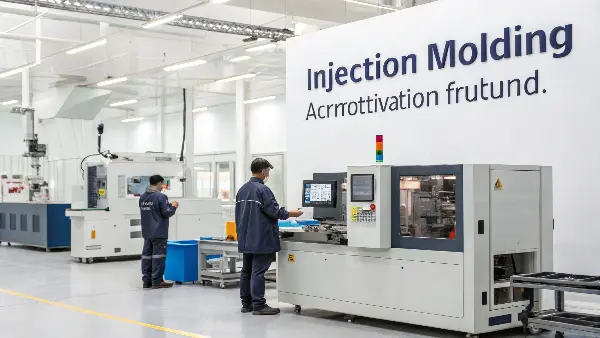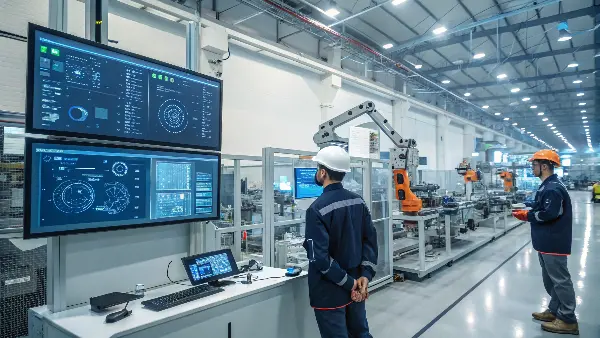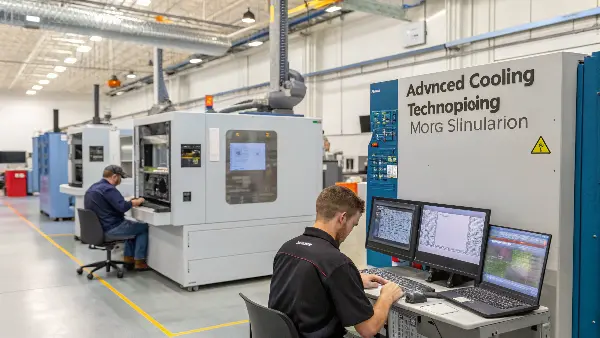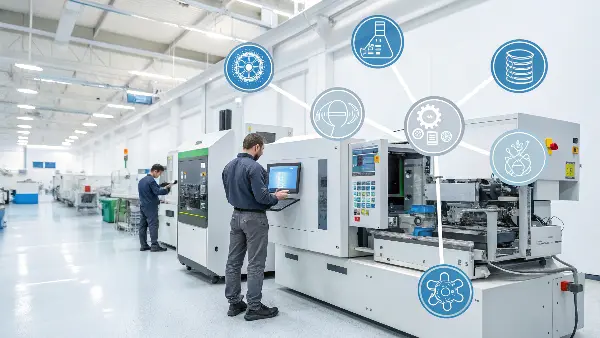Staying competitive in modern manufacturing means constantly looking ahead. If you fall behind on technology, you risk longer cycle times, lower quality parts, and losing out to more advanced competitors. Understanding the next wave of molding technology is absolutely essential for keeping your projects ahead of the curve.
The future of precision injection molding is moving toward smart manufacturing. This means using AI and IoT for greater automation and quality control. Advances in materials like bioplastics and composites, along with technologies like micro-molding and conformal cooling, are also making it possible to produce more complex and sustainable parts with incredible precision. This is the new standard we’re all moving toward.

This is just the beginning. The real advantage comes from knowing how these trends will affect your projects directly. Let’s break down what’s coming and how you can prepare for it to ensure your next project is a success. I’ll walk you through the real-world shifts I’m seeing every day in the industry.
What is the outlook for injection molding?
You’re likely wondering if investing your time and resources into new molding capabilities is a safe bet right now. Market uncertainty can make it feel risky to plan for the future, leaving you stuck with outdated processes. But the data shows a strong, growing demand for precision-molded parts.
The outlook for injection molding is very positive. The global market is expected to grow significantly over the next decade. This growth is driven by high demand from key sectors like automotive, especially for electric vehicles, medical devices, and consumer electronics. While there are challenges, the overall trend points toward more opportunities for high-precision, technologically advanced molding projects.

The demand for injection molded parts isn’t just growing; it’s evolving. As a project manager, you’re on the front lines of this shift. I recently spoke with a manager in the electric vehicle space. His biggest challenge wasn’t just designing a new component, but finding a mold maker who understood the unique requirements for high-heat-resistant polymers used in battery enclosures. This is a perfect example of where the industry is heading. It’s not just about making a part anymore; it’s about providing a specialized solution.
The primary drivers are clear, and each brings specific needs:
Key Industry Drivers
- Automotive: The shift to EVs requires lightweight components to extend battery range. This means more demand for molds that can handle advanced composites and engineering-grade plastics.
- Medical: An aging global population and a demand for more sophisticated, less invasive medical devices are fueling the need for micro-molding and parts made from biocompatible materials.
- Consumer Electronics: Everyone wants smaller, more powerful devices. This translates to a huge need for thin-wall molding and high-precision connectors.
This table breaks down where the opportunities are emerging:
| Industry Sector | Primary Market Driver | Resulting Molding Requirement |
|---|---|---|
| Automotive (EVs) | Lightweighting & Battery Tech | Molds for complex composites & high-heat plastics |
| Medical Devices | Miniaturization & Biocompatibility | Micro-molding & expertise in validated processes |
| Consumer Electronics | 5G Technology & Wearables | Precision thin-wall molding & micro-connectors |
| Sustainable Packaging | Environmental Regulations | Molds designed for bioplastics & recycled materials |
What is the future of injection molding?
The industry is changing fast, and the traditional ways of doing things are becoming less efficient. Relying on old techniques can lead to unnecessary waste, slow production speeds, and quality issues that put your projects and timelines at risk. The future is about building a smarter, more connected molding process.
The future of injection molding is a blend of digital technology and material science. We’re looking at smart factories where every machine communicates, processes are optimized by AI, and predictive maintenance is standard. Sustainability is also a huge driver, pushing the adoption of bioplastics and recycled materials. It’s a shift from just making parts to creating intelligent, efficient, and responsible manufacturing systems.

This isn’t just theory; it’s happening right now. At CavityMold, we had a client who was struggling with inconsistent dimensions on a critical part. After a lot of troubleshooting, we helped them install simple temperature and pressure sensors in their existing mold. The data immediately showed that minor temperature fluctuations in their cooling lines were causing the issue. This is a small example of what a fully connected "smart" system will do automatically, catching problems before they even result in a single bad part. This is the core of Industry 4.0 in our field.
Let’s look at the key pillars of this transformation:
Automation and Intelligence
The goal is a process that self-optimizes. IoT sensors placed within the mold and on the machine provide a continuous stream of data on everything from temperature and pressure to clamp tonnage. This information is then fed into an AI system that can adjust parameters in real-time to maintain perfect quality, reducing scrap and eliminating the need for constant manual checks.
Focus on Sustainability
The pressure to be more environmentally responsible is immense. The future lies not just in making parts that are "recyclable" but in actively using sustainable materials from the start. This includes bio-based polymers, post-consumer recycled (PCR) plastics, and designing molds that work efficiently with these sometimes-tricky materials.
| Aspect | Traditional Molding | Future "Smart" Molding |
|---|---|---|
| Process Setup | Manual, based on operator experience | AI-assisted, automatically optimized for efficiency |
| Quality Control | Manual inspection, after parts are made | Real-time monitoring, predicts defects |
| Machine Maintenance | Reactive (fix the machine when it breaks) | Predictive (AI predicts failure, scheduled maintenance) |
| Material Choice | Primarily virgin fossil-fuel-based polymers | Mix of virgin, recycled, and bioplastics |
What is the new technology for injection molding?
Knowing the general trends is one thing. But without knowing the specific technologies making it all happen, you can’t have a productive conversation with your partners or make informed choices for your projects. Let’s get into the actual tools and techniques that are making this future a reality right now.
New key technologies include conformal cooling, which revolutionizes mold temperature control for faster cycles and better part quality. We also have advanced simulation software that predicts molding outcomes with incredible accuracy. Finally, micro-molding and 3D printed mold inserts are opening doors to producing extremely small, complex parts and rapid prototypes that were impossible before.

I remember working on a medical device project a while back. The part had a deep, thin feature that was impossible to cool evenly with traditional straight-drilled cooling lines. It caused a persistent sink mark that was a critical defect. By creating a mold insert with 3D-printed conformal cooling channels, we solved the problem completely. Not only that, we cut the cycle time nearly in half. This is the kind of practical impact we’re talking about.
Here are the technologies you need to know:
Conformal Cooling
Instead of straight cooling channels drilled into the mold, this technique uses metal 3D printing to create channels that precisely follow the contour of the part. This allows for incredibly uniform and fast cooling, which drastically reduces cycle times and prevents issues like warp and sink marks.
Advanced Simulation
Modern mold flow software is more powerful than ever. It goes beyond just predicting how plastic will fill a cavity. It can simulate cooling efficiency, predict part warpage with high accuracy, and identify potential stress points in the final product. It lets us solve problems before we ever cut steel.
Micro-Molding
This specialized process is designed to produce parts that are incredibly small, sometimes weighing just a fraction of a gram. It requires dedicated machinery and ultra-precision molds to create tiny gears, connectors, and medical implants that are essential for today’s technology.
| Technology | Primary Benefit | Ideal Application |
|---|---|---|
| Conformal Cooling | Faster Cycle Times, Reduced Warpage | Complex part geometries, high-volume production |
| Advanced Simulation | Risk Reduction, Pre-production Problem Solving | All new projects, especially complex or high-cost tools |
| Micro-Molding | Extreme Precision & Miniaturization | Medical implants, micro-electronics, watches |
| 3D Printed Inserts | Design Freedom, Rapid Tooling Changes | Prototyping, complex features, conformal cooling |
What is the projected area of injection molding?
New technology is exciting, but it’s only valuable when it solves a real-world problem. You need to know which industries are driving this innovation to see where the biggest opportunities for your projects lie. The application of these advanced techniques is expanding rapidly into new and demanding fields.
The projected areas for growth in injection molding are heavily concentrated in sectors requiring high precision and advanced materials. This includes the electric vehicle market for lightweight structural components, the medical industry for biocompatible and micro-sized devices, and personalized consumer electronics where complex, aesthetically pleasing designs are key. These fields are pushing the boundaries of what molding can achieve.

Projected "area" isn’t just about the physical size of a part—it’s about the application areas where growth is exploding. I’m seeing this firsthand. We are getting more and more inquiries from companies in aerospace and robotics. They are looking to replace traditionally metal parts with lighter, yet equally strong, components made from high-performance polymers like PEEK and Ultem. They aren’t just looking for a molder; they are looking for a materials and engineering partner who understands the unique challenges of their industry.
The demand is not uniform; it’s specific. Here’s how these growth areas are shaping molding requirements:
High-Growth Applications
- Medical & Healthcare: The demand is for absolute perfection. This means molds for single-use diagnostic tools, drug-delivery systems, and long-term implants. Everything must be traceable, made with biocompatible materials, and often produced in a cleanroom environment. Micro-molding is essential here.
- Electric Vehicles (EVs) & Automotive: Beyond simple interior trim, molding is now used for battery casings, lightweight chassis components, and intricate sensor housings. These require molds that can handle fiber-reinforced composites and withstand high temperatures and vibration.
- Personalized Electronics: Consumers want unique products. This is driving the use of techniques like overmolding and insert molding to create devices with soft-touch grips, integrated electronics, and custom color schemes, all produced efficiently at scale.
| Application Area | Key Challenge | Required Molding Technology |
|---|---|---|
| Medical Implants | Biocompatibility, Sterilization, Precision | Micro-molding, Scientific Molding, Validated Processes |
| EV Battery Systems | Heat Resistance, Structural Strength | Molds for engineering composites, Conformal Cooling |
| Smart Home Devices | Aesthetics, Complex Geometry, Integration | High-precision multi-cavity molds, Overmolding |
| Aerospace Components | Weight Reduction, High Strength | Molds for PEEK/Ultem, Metal-to-plastic conversion |
Conclusion
The future of precision injection molding is bright, but it requires adaptation. The convergence of smart technology like AI, advanced materials, and sustainable practices is redefining what’s possible. By understanding and embracing these trends, you can ensure your projects are efficient, innovative, and maintain their competitive edge.
